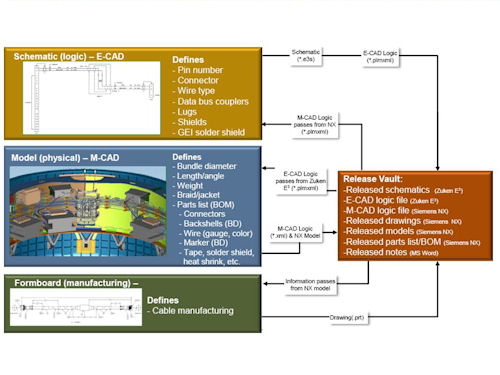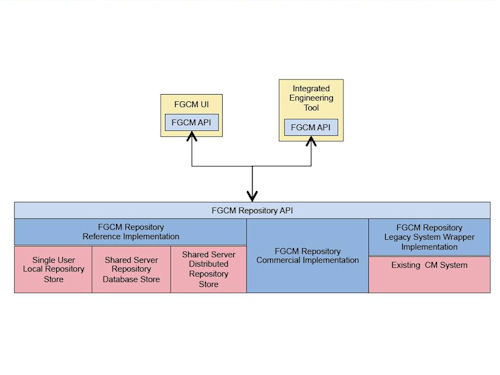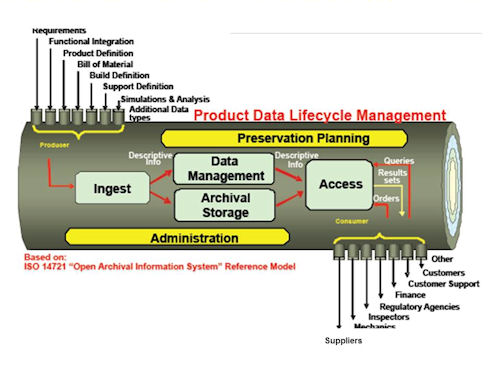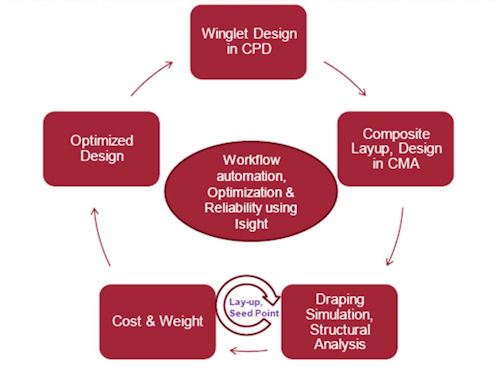Improve Engineering Data Interoperability
The Global Product Data Interoperability Summit aims to drive standards adoption in aerospace, automotive and other industries.
December 4, 2001
By Randy Frank
With a theme of “Enabling Productivity with Common Data Streams,” the Global Product Data Interoperability Summit (GPDIS) 2013 focused on data exchange tools, manufacturing and quality systems, data exchange/product lifecycle management (PLM), and service-oriented architecture (SOA)/cloud. A sample or two from each track provides an idea of the changes that are occurring in these areas.
PLM Interoperability
In late 2012, Siemens’ JT data format was accepted as the first International Organization for Standardization (ISO) international standard for viewing and sharing lightweight 3D product information. Explained in ISO IS14306, the format provides corporations and software vendors the ability to leverage JT in PLM workflow and software applications. In his presentation, “PLM at ATK,” Jon Jarrett, a director at ATK, shared the success ATK has experienced with the new standard.
 Fig. 1: Logic models in ECAD, physical models in MCAD and manufacturing requirements provide inputs and get information from the release vault. |
“Using JT as an exchange mechanism has been a big differentiator for us,” he says. Jarrett explains that the JT format delivery has been preferred when working with customers in space, defense and commercial applications; it has helped identify standard parts used across corporate organizations and government agencies. (See Fig. 1.)
For example, using 3D models delivered in JT and a standard parts management process, interoperability results from NASA’s SLS booster program include:
- requiring almost 16 fewer cable modelers for the selective laser sintering (SLS) booster design;
- reducing the number of designers needed for delivery of the SLS booster model design by about 40% because of reuse; and
- reducing the SLS preliminary design review (PDR) schedule by about nine months.
Rather than reporting on the success of a recently established standard, Rainer Romatka, Ph.D., of The Boeing Co. wants to establish a new standard. In his presentation “Generic Configuration Management for Engineering Data,” he proposes that the industry establish an “Industry Standard for a Federated, Generic Configuration Management (FGCM).” (See Fig. 2.)
With a goal of storing, exchanging, integrating and providing traceability across the infrastructure, data does not have to be changed for export or import with this proposed standard, so that users can establish workflows that span multiple repositories. However, different models, purchasing agreements, different fidelity of the models and other real-world aspects can all lead to variations in the end requirements.
“I don’t think we’ll ever get to a point where one vendor can provide all the tools that we need for the job,” Romatka points out. “They use different types of data representations because the problems are different.”
In the system he proposes, one model needs to know the impact of a change in another model that is related to the change requiring extensive tracking capability. To accomplish this, the configuration management system needs to know the structure of the data a user wants to store in it.
When implemented, the FGCM would provide repository access through a standards-based interface, as well as interoperability of implementations by different vendors.
Data Exchange Standards for Interoperability
Because digital data is used in many different ways throughout a business in a product’s lifecycle, the transition to a standardized model-centric approach for structured digital data is required. Rick Zuray, technical principal at The Boeing Co., addressed these issues in “LOTAR: Managing a Model-based Enterprise.”
 Fig. 2:The FGCM architecture includes an application programming interface for a user interface (UI) and integrated engineering tool. |
The ease of storing digital data has created new challenges and increased complexity for data that needs to be archived. Length of storage, data ownership and operational requirements on the system are a few key aspects driven by information requirements, as are business results; repository retention period, format and processes; and systems in the enterprise.
The standards-based solution is Long-term Archiving and Retrieval (LOTAR), established in January 2003 by the LOTAR International Consortium. The working group is sponsored under a hosting organization consisting of the Aerospace Industries Association (AIA), PDES Inc., Aerospace & Defense Industries of Europe” Standardization (ASD-STAN) and ProSTEP iViP. (See Fig. 3.)
Using the data in one form and storing it in another format is a simplified way to describe LOTAR. With the goal of a standard by this month, suppliers participating in the ISO and LOTAR teams have made significant contributions to the process—providing ideas and critiques as the specs are developed.
“We’ve found that it’s easier to get a standard out faster that way, if you get the vendors involved more up front instead of getting a standard out there and saying ‘You need to support this,’” says Zuray.
Suppliers start working on implementation before the standard is finalized to demonstrate feasibility; they can propose alternatives if some aspects are problematic.
Data Exchange Tools for Interoperability
In his presentation “Multi-user Interoperable CAx Tools,” C. Greg Jensen, Ph.D., from Brigham Young University (BYU), explained how BYU-developed multi-user adaptations of NX and CATIA, called NX Connect and CATIA Connect, allow multiple designers to simultaneously contribute to the same part or assembly model.
“The design process does not really have to be serial,” explains Jensen. A side-by-side comparison with students collaborating vs. a single student working alone yielded about a two-thirds reduction in required time for a simulated project. This can translate into a time savings of weeks, or even months in a real program—and get a product to market much sooner.
With impressive results from his efforts, Jensen says he is looking forward to the next phases of research. Working with a consortium of prime defense contractors, BYU plans on developing a CAx application- and data-neutral architecture for use in multi-user CAx.
Global organizations communicate using English as a common language. “They all speak English, but not the same English,” observes Roland Maranzana, Ph.D., of 3DSemantix. As a result, he says, a text-based description can have many different meanings.
In his presentation, “3D Mining for Part and Information Reuse in a PLM Context,” Maranzana proposes to address the limitations and problems with traditional text-based searches with a 3D-based search engine for engineering. With this approach, mechanical components can be visually searched with 3DSemantix 3DPartFinder.
For CAD systems, 3DPartFinder V4 can be used with: CATIA V5, NX 7 or 8, PTC Pro-E and Creo, SolidWorks 2012-2014, Autodesk Inventor 2013-2014, and Solid Edge ST4, ST5.
PLM In-depth
Although one may think of interoperability as making sense only for large companies, small companies can still derive several benefits from the concept. John Loo of VMH International (VMHI) addressed this opportunity in his presentation, “The Potential Impact of Cloud-based PLM on Small Supplier Quality Process.”
Loo notes that while small suppliers have faster response, less overhead and more flexibility on pricing, they are often challenged by capital/cash flow constraints, capacity constraints and infrastructure issues. Cloud computing with virtual machines (VMs)—and the ability to add and delete resources as required—makes it an attractive tool that can provide a solution, including software-as-a-service (SaaS).
Loo states that cloud-based PLM offers small companies many advantages, including:
- paying only for what you use, when you use it;
- tracking costs at a granular level;
- reducing staffing and facility costs; and
- expanding easily.
Siemens CAD (NX 8, 8.5; SolidEdge ST5), Teamcenter Visualization tools, Microsoft Office, and Cortona 3D.
 Fig. 3: The LOTAR data management pipeline receives various inputs from a producer—and outputs from a customer. |
Applied across different business applications, Loo says the results include excellent reliability and VM performance with very good network performance—“all things considered.”
 Fig. 4: The composite workflow analysis uses Isight for workflow automation, optimization and reliability. |
“Cloud-based PLM obviously is not a panacea,” Loo quips, adding that it does, however, offer advantages to small business and others. These include:
- The option of implementing PLM at a reduced cost.
- The potential for more SaaS offerings and reduced pricing, thanks to competition and technology advances.
Data Exchange/PLM
Composite materials allow designers to achieve considerable design improvements, but they require more thorough analysis than traditional materials. In their presentation “Achieve a Robust and Manufacturable Composite Design,” Mahesh Turaga, Ph.D., and Bill Brothers from Dassault Systemes used a bent wing design for an airplane to show how analysis of 74,613 variable possibilities for analysis could be reduced and managed.
Using a variety of seed points, the point of first application point for a composite ply, the analysis employed gradient, direct and exploratory techniques with cost and weight comparisons to determine the acceptable reliable, robust design. Alternative drapings, the process of applying a flat sheet material to a mold surface, were part of the analysis.
The analysis used Dassault’s Isight in an integrated process that automatically drives variables across tools and manages results. The evaluation involved the exchange of data through five separate data management software segments. (See Fig. 4.)
The base design used 16 plies, took two weeks to achieve and had a deflection of 5.9 in. vs. a design goal of less than 5 in. and max strain of 30.9 lb., versus a design goal of less than 30 lb. In contrast, the optimized design used 10 plies, took about 2 minutes and delivered deflection of 4.1 in. and max strain of 26.8 lb.—meeting design goals in these areas and others.
The final presentation in the Data Exchange/PLM track was “Collaborate to Innovate with Engineering Virtual Desktop Infrastructure (eVDI).” Nicholas Holian and Rob Link of Hewlett-Packard showed how to address today’s issue of achieving security, speed of design from idea to manufacturing, and collaboration across an expansive ecosystem—all while overcoming obstacles that appeared within the last 15 years.
HP engineers had the goal of creating a centralized engineering environment, “putting all the pieces of product development engineering into a single ecosystem, and they are all interconnected together,” explains Holian.
The solution, evaluated in HP ecosystem, used a centralized engineering environment and several services. The result, eVDI, is a globally accessible information platform for engineering virtualized 3D visualization.
Randy Frank is a contributor to DE. Send e-mail about this article to [email protected].
More Info
- Presentations are accessible without requiring a password at GPDISonline.com/schedule.html
- 3DSemantix
- Aerospace & Defense Industries of Europe—Standardization
- Aerospace Industries Association
- ATK
- The Boeing Co.
- Brigham Young University
- Dassault Systemes
- Hewlett-Packard
- LOTAR International Consortium
- PDES Inc.
- ProSTEP iViP
- Siemens
- VMH International
Subscribe to our FREE magazine, FREE email newsletters or both!
About the Author
Randy FrankRandy Frank is a freelance technology writer based in Arizona. Contact him via [email protected].
Follow DE





